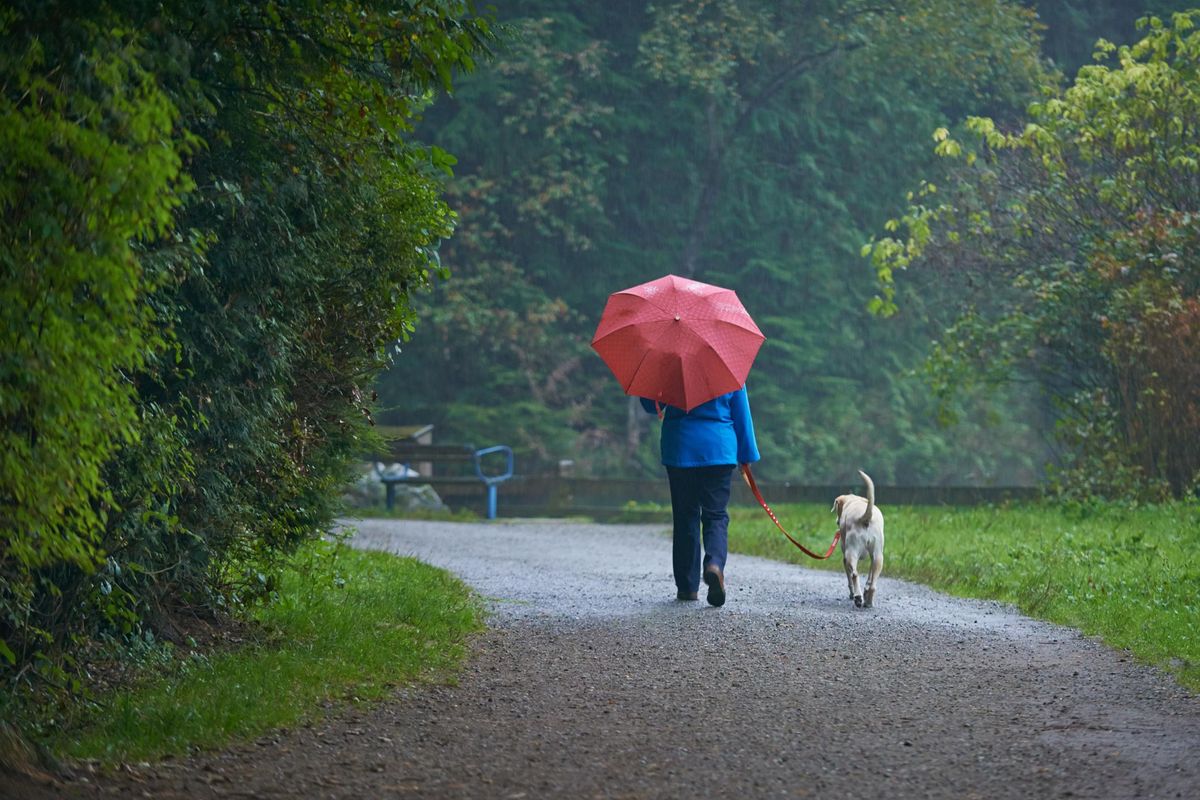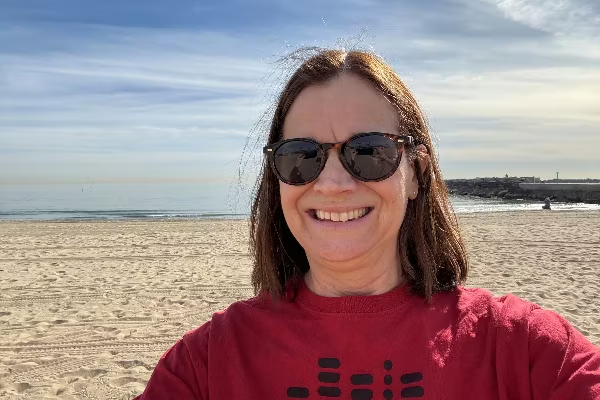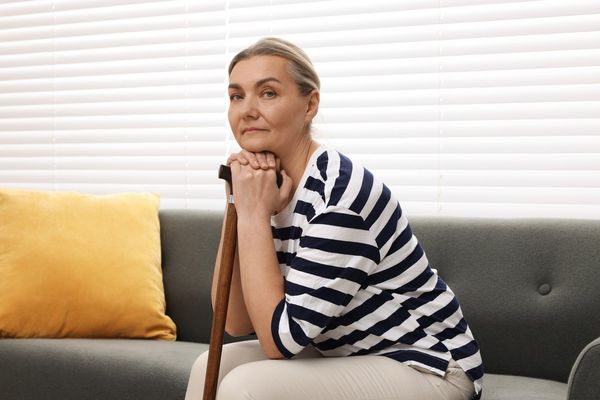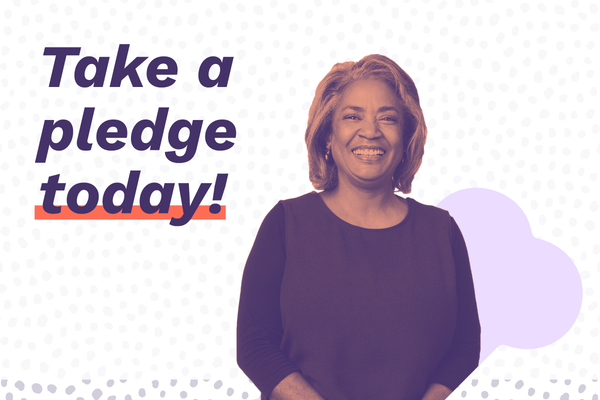On a rainy day in October 2020, Carmella*, a 58-year-old mental health counselor, was walking her dog when the dog got spooked by a storm and ran off-leash, causing Carmella to fall on her back with both feet in the air. Carmella tried to manage the back pain over the next few days by taking acetaminophen and taking it easy.
But the pain didn't go away. Coincidentally, Carmella's OB-GYN had previously scheduled her for a bone density DEXA scan the next week. It turned out she had severe osteoporosis, which occurs when the body makes too little bone or loses bone faster than new bone cells are created — and she had fractured her T2 and T3 vertebrae.
This fall was not Carmella's only major accident. Over 11 years before, she broke her dominant left wrist, and in January 2017, she fell down a few stairs and suffered a vertebral compression fracture of her T12 vertebrae.
Due to Covid-19 restrictions, Carmella had initially postponed the serendipitous OB-GYN appointment that ultimately led to her diagnosis. If the appointment had been sooner, she would have been sent to the bone density scan and discovered her osteoporosis diagnosis earlier, which could have led to her taking precautions that may have prevented the second vertebrae fractures.
After receiving her test results, she scheduled an appointment with an osteoporosis specialist –– the earliest slot was three months away — again, due to pandemic-related delays.
Osteoporosis often goes undiagnosed or untreated
According to the National Osteoporosis Foundation (NOF), about 54 million Americans live with osteoporosis, and approximately one in two women and one in four men ages 50 and older will break a bone due to the condition.
As it did in Carmella's case, osteoporosis often goes undiagnosed by general practitioners and other healthcare providers. Dr. Ethel Siris, professor of medicine at Columbia University Medical Center and special advisor to NOF, explains why this might happen.
"Some of the reasons [osteoporosis] goes undiagnosed have to do with the way medicine is practiced today, where a physician in general practice has a minimal amount of time at a patient visit. And typically, if it's a wellness visit, which involves a history and a physical, [bone density] just doesn't come up. If [the appointment] involves the patient coming in with a complaint … the entire visit will focus on that specific complaint. There's no time to try to go into … 'we really ought to do a bone density on you.'"
Carmella wishes that her healthcare provider had informed her of the dangers of back pain and vertebral compression fractures when she first fell over a decade ago. "I wish that women were made aware of risk factors," she said. "But for me [my back pain] just got worse and worse right under my nose."
She now knows that if you break a bone when falling from a standing position, especially post-menopause, you definitely should consult your doctor about getting a bone density scan. Carmella explained, "I thought hormone therapy was enough to avoid menopause symptoms and that I would be 'tough' and just get through [the pain]. I didn't realize that, as my hormones tanked, I suffered worse and worse bone loss."
Covid-19 poses new challenges and situations
According to Siris, the biggest challenge people with osteoporosis face in the pandemic is receiving the necessary shot (denosumab) or IV infusion (zoledronic acid injection) to treat their condition. Both drugs are bisphosphonates — a class of drugs that prevent bone density loss — and among the most common pharmaceutical treatment options for osteoporosis. The IV treatment must be administered at an infusion center, but since it's given just once a year (for three to six years), the drug lingers in the body longer, and a dose can be delayed for a few months.
On the other hand, one missed dose of denosumab, a shot in the arm every six months, can significantly expedite bone loss. Studies have shown that spontaneous vertebral fractures can occur as soon as eight months after the last injection. Another challenge people are facing is receiving in-person, hands-on fracture treatment and physical therapy sessions.
On April 7, 2020, the Center for Medicaid and Medicare Services postponed nonemergency and elective services, including popular osteoporosis treatment procedures like vertebroplasty and kyphoplasty, both surgical procedures for pain management. Considering osteoporosis primarily affects older adults, who are at risk for complications from Covid-19, many appointments that are necessary for potential diagnoses are being delayed for older patients. Doctors, like Dr. Siris, can help them continue the care they need through frequent virtual check-ins to monitor pain and the dosages of pain medication.
"In terms of getting people diagnosed," explains Siris, "clearly, if people don't go to the doctor … they're not going to get the test. And if you delay getting a test which, if positive for osteoporosis, would get somebody started on treatment, then that's to the patient's great disadvantage."
Although in-person appointments may not happen, telemedicine does allow Siris to see already-diagnosed patients. Through telemedicine video appointments, she can assess how patients are walking, detect spinal curvature, refill prescriptions and screen for comorbidities such as depression.
"The primary thing I focus on is whether the patient is moving well, or is the patient frail? Is the patient able to get up easily when the patient walks? I can watch everybody as they walk 10 feet or so away from the phone and back. When they turn in profile, I see if they have any curvature in the back, which might reflect a fracture ... you can learn a lot watching somebody walk in terms of whether they're at higher risk of fracture," Siris said.
The importance of preventing comorbidities and other negative outcomes
Physical exercise is undoubtedly the most effective way to build and maintain bone density in patients with osteoporosis. The first type of exercise to focus on is weight-bearing activities that make you move against gravity while standing upright, like dancing and stair climbing. The second type is muscle-strengthening exercises that make you have resistance against gravity, such as by lifting weights or your own body weight.
"The role of exercise is primarily to help people be less likely to fall," Siris said. "If older people can be physically fit, and they're in better shape, they're much less likely to fall down."
She added that people do not necessarily have to go to the gym to do these exercises. Following an aerobics exercise video at home, using the stairs and walking around the neighborhood are some of the safe and straightforward ways to stay active, even during a pandemic.
Several key nutrients also can help you maintain strong bones and prevent fractures: calcium; vitamins D, C, and K; protein; magnesium; and zinc. Maintaining good bone health helps with osteoporosis and prevents common comorbidities such as dementia or cognitive impairment, diabetes and cancer.
Last, preventing fractures can also reduce the complications associated with Covid-19. Vertebral fractures are linked to severe respiratory failure, putting people at high risk of pneumonia, and, in turn, Covid-19, leading to poor recovery outcomes.
*Because of the nature of her profession, Carmella requested we refer to her only by her first name.
This resource was created with support from Medtronic.
- Staying Fracture-Free - HealthyWomen ›
- How is Osteoporosis Diagnosed - HealthyWomen ›
- Osteoporosis - HealthyWomen ›






